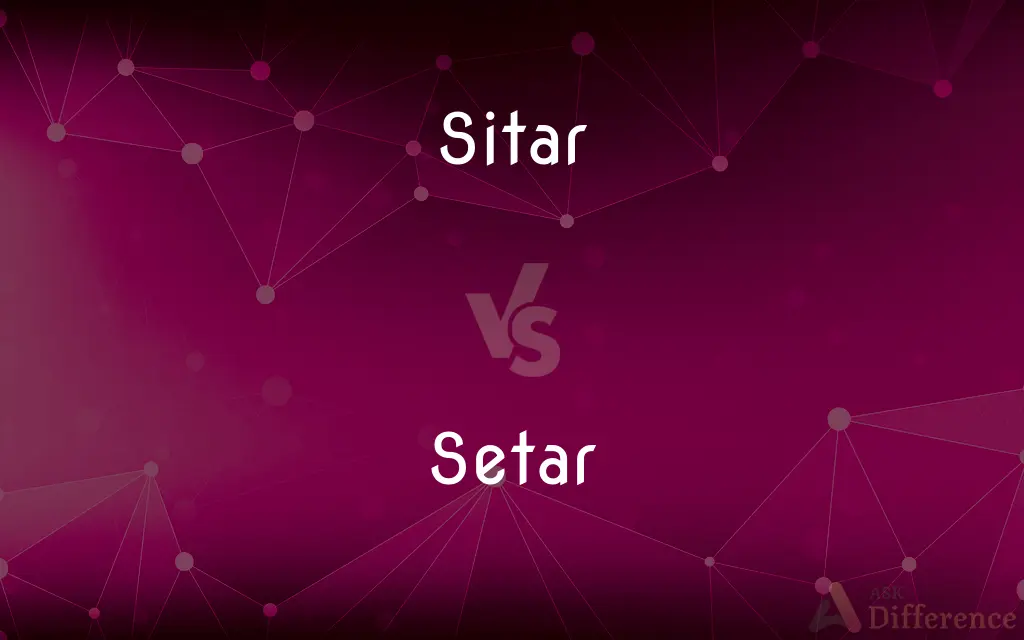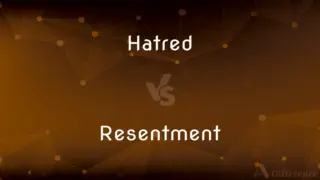Sitar vs. Setar — What's the Difference?
By Urooj Arif & Maham Liaqat — Updated on March 26, 2024
The sitar, a prominent Indian string instrument, is known for its deep, resonant sound and complex playing techniques, while the setar, with roots in Persian music, offers a softer tone and simpler structure.

Difference Between Sitar and Setar
Table of Contents
ADVERTISEMENT
Key Differences
The sitar and setar, both plucked string instruments, originate from different cultural backgrounds, which significantly influences their construction, sound, and playing techniques. On the other hand, the setar is a much smaller instrument, with its origins tracing back to Persia (modern-day Iran). It has a slender neck and a smaller body, usually made of wood, and typically features four strings, though older versions had three.
While the sitar's playing technique involves a complex combination of plucking, gliding, and bending strings to produce a wide range of musical expressions, the setar's technique focuses more on the delicacy of touch and the nuance of the plucked note. Players of the sitar use a metal plectrum worn on the finger, allowing for dynamic and expressive playing, whereas setar players pluck the strings directly with their fingernails, which demands precise control and subtle articulations.
The construction of these instruments also highlights their cultural differences. The sitar often features elaborate decorations and inlays, reflecting the rich visual aesthetics of India. In contrast, the setar tends to have a simpler design, focusing more on the purity of sound than on visual embellishment, which mirrors the philosophical and spiritual aspects of Persian culture.
The repertoire and musical scales associated with each instrument differ, reflecting their distinct musical traditions. The sitar is often played in the context of raga, a framework of melodic structure in Indian classical music that allows for improvisation and expression. Meanwhile, the setar is commonly associated with radif, the traditional Persian music repertoire that consists of several hundred short melodic movements, each serving as a basis for improvisation and creation.
Comparison Chart
Origin
India
Persia (Iran)
ADVERTISEMENT
Size & Shape
Large with a long neck and gourd body
Smaller, slender neck and wooden body
Number of Strings
18-21, including played and sympathetic strings
3-4, all played
Sound
Deep, resonant, capable of a wide range of sounds
Softer, more intimate
Playing Technique
Uses a metal plectrum, emphasizes bending and gliding
Plucked directly with fingernails, focuses on subtlety
Compare with Definitions
Sitar
Features decorative inlays and elaborate craftsmanship.
The beautifully decorated sitar was as much a visual art piece as a musical instrument.
Setar
Typically has four strings, with older versions having three.
The musician tuned his setar meticulously, ensuring each string resonated perfectly.
Sitar
Played with a metal plectrum attached to the index finger.
Skillfully wielding the plectrum, the musician brought the sitar to life.
Setar
Played with the fingernails, allowing for subtle expression.
With precise movements, the setar player plucked the strings, creating a captivating melody.
Sitar
Known for its rich, resonant sound, made possible by its numerous strings.
The sitar's deep vibrations filled the concert hall, leaving a lasting impression.
Setar
Emphasizes simplicity in design, focusing on the purity of sound.
The simple yet elegant setar was a testament to the artist's focus on musical essence.
Sitar
A classical Indian string instrument with a long neck and a gourd body.
The sitar player captivated the audience with intricate ragas.
Setar
Central to Persian classical and folk music traditions.
The setar performance was a deep dive into the rich traditions of Persian music.
Sitar
Associated with classical Indian music and the performance of ragas.
The sitar concert featured an exquisite selection of classical ragas.
Setar
A Persian string instrument known for its delicate sound and wooden body.
The setar's gentle melody added a touch of intimacy to the evening.
Sitar
The sitar (English: or ; IAST: sitāra) is a plucked stringed instrument, originating from the Indian subcontinent, used in Hindustani classical music. The instrument was invented in medieval India and flourished in the 16th and 17th centuries and arrived at its present form in 18th-century India.
Setar
A setar (Persian: سهتار, pronounced [seˈt̪ʰɒːɾ]) is a stringed instrument, a type of lute used in Persian traditional music, played solo or accompanying voice. It is a member of the tanbur family of long-necked lutes with a range of more than two and a half octaves.
Sitar
A stringed instrument of India having a seasoned gourd for a body and a hollow wooden neck with movable raised frets. Stretched over the frets are usually 6 or 7 metal strings on which the melody is played with a pick, and stretched under the frets are 11 or more sympathetic resonating strings.
Setar
A Persian musical instrument
Sitar
(musical instruments) A Hindustani/Indian classical stringed instrument, typically having a gourd as its resonating chamber.
Sitar
A stringed instrument of India; has a long neck and movable frets; has 6 or 7 metal strings for playing and usually 13 resonating strings
Common Curiosities
What kind of music is the sitar associated with?
The sitar is primarily associated with classical Indian music, especially the performance of ragas.
What is the setar?
The setar is a Persian string instrument with a softer, more intimate sound, typically featuring four strings.
How many strings does a sitar have?
A sitar typically has 18-21 strings, including played and sympathetic strings.
How is the sitar played?
The sitar is played with a metal plectrum attached to the index finger, allowing for a variety of expressive techniques.
What kind of music is the setar used in?
The setar is used in Persian classical and folk music, known for its intricate melodies and emotional depth.
Are there specific techniques unique to playing the sitar?
Yes, playing the sitar involves unique techniques like bending and gliding the strings for expressive sound.
How is the setar played?
The setar is played with the fingernails, focusing on subtlety and precise control of each note.
What are the main differences in sound between the sitar and setar?
The sitar produces a deep, resonant sound capable of a wide range of expressions, while the setar offers a softer, more intimate tone.
What is the sitar?
The sitar is a classical Indian string instrument known for its deep, resonant sound and complex playing techniques.
What influences the unique sound of the sitar?
The sitar's unique sound is influenced by its construction, including the sympathetic strings that resonate to enhance its tone.
How many strings does a setar have?
A setar typically has four strings, though older versions may have only three.
What is the significance of the setar in Persian music?
The setar holds a significant place in Persian music, valued for its ability to convey subtle emotions and nuances.
Can the sitar and setar be used interchangeably in music?
Due to their distinct sounds and musical traditions, the sitar and setar are not typically used interchangeably.
Share Your Discovery

Previous Comparison
Hatred vs. Resentment
Next Comparison
Identity vs. IdentificationAuthor Spotlight
Written by
Urooj ArifUrooj is a skilled content writer at Ask Difference, known for her exceptional ability to simplify complex topics into engaging and informative content. With a passion for research and a flair for clear, concise writing, she consistently delivers articles that resonate with our diverse audience.
Co-written by
Maham Liaqat














































